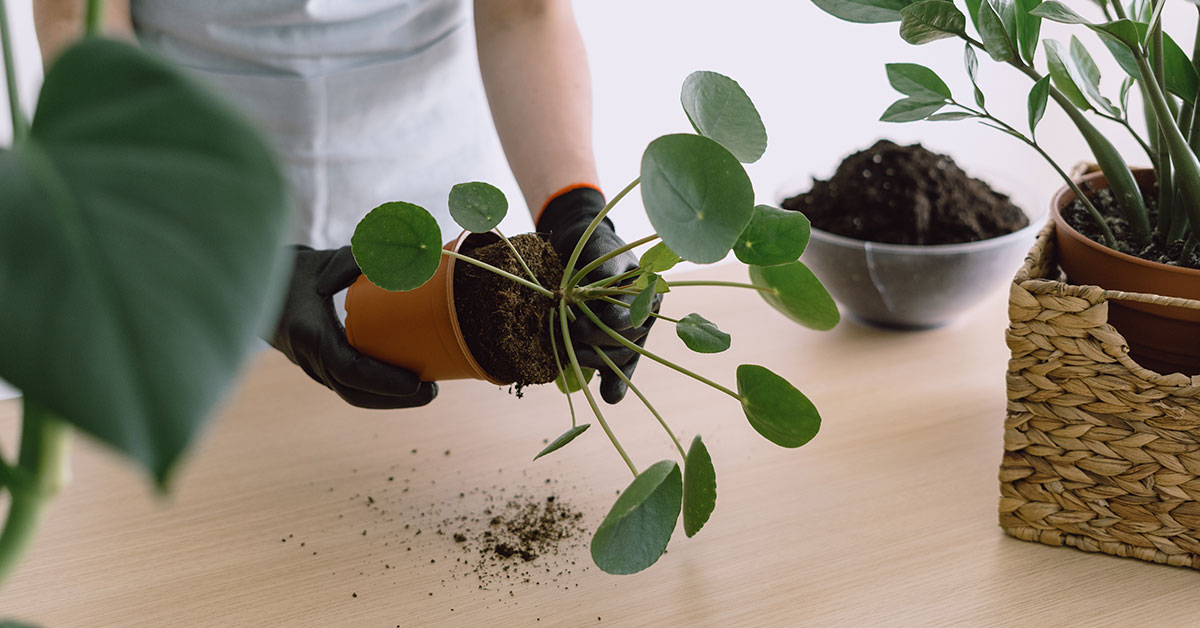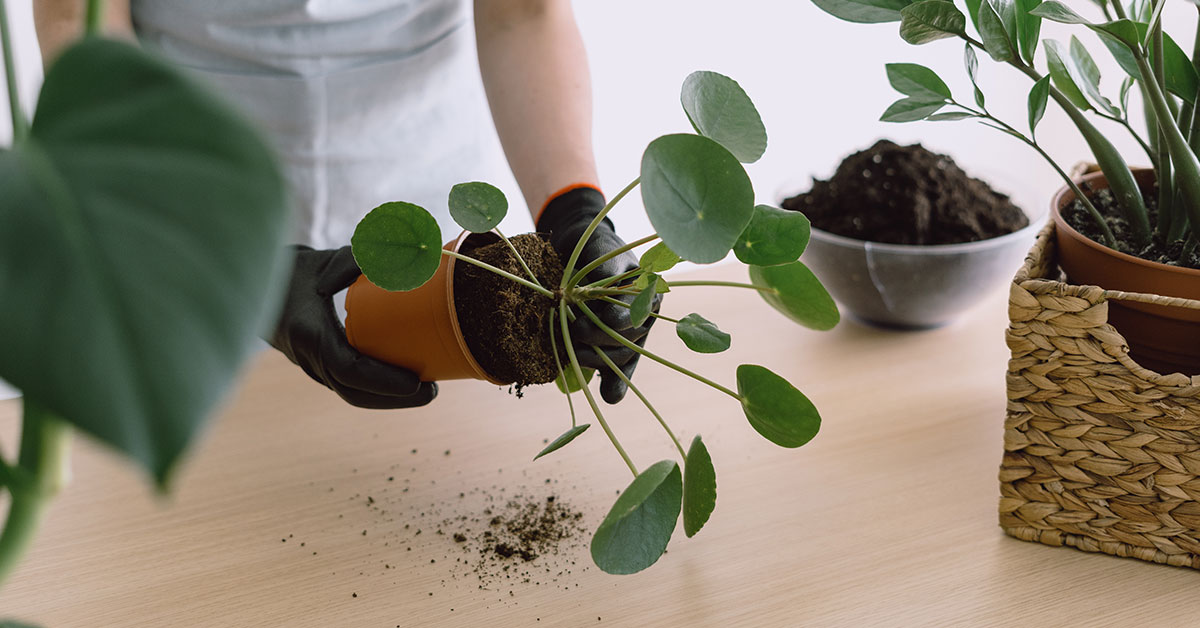How To Repot Your Money Plant Without Damaging It is a crucial skill for any plant enthusiast. This resilient houseplant, known for its lush foliage and air-purifying qualities, thrives when given the right care. Repotting, while essential for its continued growth, can be a delicate process if not done correctly.
This guide will equip you with the knowledge and techniques to safely repot your money plant, ensuring its health and longevity.
The money plant, scientifically known as Epipremnum aureum, is a popular choice for indoor gardens due to its adaptability and low-maintenance nature. However, like any plant, it requires periodic repotting as its roots grow and fill its existing container. Repotting provides fresh soil, essential nutrients, and ample space for the roots to flourish, ultimately contributing to a healthier and more vibrant plant.
Understanding the Money Plant

The money plant, scientifically known asEpipremnum aureum*, is a popular houseplant renowned for its lush foliage and easy-to-care-for nature. Its resilience and adaptability make it a perfect choice for both beginner and experienced plant enthusiasts.The money plant is a vigorous vine that can grow to impressive lengths, cascading beautifully from hanging baskets or climbing up trellises.
Repotting your money plant is a crucial step in its care, ensuring healthy growth and preventing root damage. Just like maintaining a lush chamomile lawn, keeping your chamomile lawn pest-free requires consistent attention. Similar to pests in your lawn, overwatering can also harm your money plant, so ensure proper drainage and choose the right potting mix for optimal growth.
It features heart-shaped leaves that come in a variety of shades, from deep green to variegated patterns of yellow and white. This versatility makes it a decorative addition to any home or office space.
Repotting a money plant requires a gentle touch, similar to the meticulous care involved in cultivating Bonsai. Both practices emphasize preserving the delicate root systems. When repotting your money plant, use a well-draining potting mix and a pot slightly larger than the previous one.
This allows the roots to expand without being overly stressed, mirroring the gradual growth of a Bonsai tree.
The Money Plant’s Growth Habits
The money plant thrives in warm, humid environments and prefers bright, indirect light. It can tolerate low light conditions but may experience slower growth and less vibrant foliage. Its vigorous growth makes it a fast-growing plant, requiring regular repotting to accommodate its expanding root system.
Importance of Repotting
Repotting is crucial for the health and growth of your money plant. As the plant matures, its roots become crowded in the existing pot, leading to stunted growth, nutrient deficiencies, and even root rot. Repotting provides the plant with fresh potting mix and ample space for its roots to thrive.
Signs That Your Money Plant Needs Repotting
Several signs indicate that your money plant requires a larger pot. These include:
- Roots growing out of the drainage holes.
- The plant becoming top-heavy and unstable in its pot.
- Slowed growth or yellowing leaves.
- The plant becoming pot-bound, with roots circling the inside of the pot.
Choosing the Right Pot
When selecting a new pot for your money plant, consider the following:
- Size:The new pot should be just slightly larger than the previous one, allowing for about an inch of space around the root ball. A pot that is too large can lead to overwatering and root problems.
- Material:Terracotta pots allow for better drainage but can dry out faster, while plastic pots retain moisture. Choose the material that best suits your watering habits and environmental conditions.
- Drainage Holes:Ensure that the new pot has adequate drainage holes to prevent waterlogging.
Preparing for Repotting

Repotting your money plant is an essential step in ensuring its continued growth and health. Before you begin, gather the necessary materials and choose the right time to repot.
Materials Needed for Repotting
The right tools and materials are crucial for a successful repotting process. These include:
- New Pot:Choose a pot that is slightly larger than the current pot, allowing for root growth. The new pot should have drainage holes to prevent waterlogging. Ensure the pot is made of a material that suits the plant’s needs, such as terracotta, ceramic, or plastic.
- Potting Mix:Use a well-draining potting mix specifically designed for indoor plants. Avoid using garden soil, which can compact and impede drainage.
- Tools:You will need a few basic tools for repotting, including a trowel or gardening spade, a pair of gardening gloves, and a watering can.
Timing for Repotting
The best time to repot a money plant is during the spring or early summer when it is actively growing. Repotting during these months allows the plant to adjust to its new pot and soil more easily. Avoid repotting during the winter months when the plant is dormant.
Repotting your money plant requires a gentle touch, just like choosing the right companion plants for your hydrangeas. While repotting, avoid disturbing the roots too much, similar to how you’d want to protect your hydrangeas from harsh winds by planting wind-resistant companions like evergreens or shrubs.
These companion plants can create a protective barrier, much like the loose soil you use when repotting your money plant, allowing it to thrive in its new home.
Repotting Process
Now that you have everything prepared, it’s time to carefully move your money plant to its new home. This process requires patience and gentle handling to minimize stress on the plant.
Gently Removing the Money Plant
Removing the money plant from its current pot without damaging its roots is crucial. This process involves loosening the plant and carefully extracting it, ensuring minimal disturbance to the root system.
- Water the plant thoroughlya day before repotting. This helps loosen the soil and makes it easier to remove the plant.
- Gently tap the base of the potto loosen the plant. You can also use a tool like a trowel or a butter knife to gently pry the plant away from the pot’s edges.
- Hold the plant firmly at the baseand carefully lift it out of the pot. Avoid pulling on the stems or leaves, as this can damage the plant.
- Inspect the rootsfor any signs of damage or rot. If you find any, carefully trim them with clean, sharp scissors.
Adding Fresh Potting Mix, How To Repot Your Money Plant Without Damaging It
Once the money plant is out of its old pot, it’s time to prepare its new home. This involves adding fresh potting mix to the new pot, ensuring adequate drainage for healthy growth.
- Fill the new pot with potting mix, leaving about 2 inches of space at the top. Use a high-quality potting mix specifically designed for indoor plants.
- Create a small mound in the centerof the potting mix. This will help position the plant at the correct height.
- Add a layer of drainage materialat the bottom of the pot, such as gravel or pebbles. This helps prevent waterlogging and promotes healthy root growth.
Positioning the Plant
Positioning the money plant in the new pot is crucial for its stability and growth. This involves considering the size and root structure of the plant and ensuring it’s placed at the right depth.
- Place the money plant on the moundin the center of the pot. Ensure the plant is positioned at the same depth as it was in the old pot.
- Fill in the gaps around the plantwith more potting mix. Gently press the soil around the roots to ensure stability.
- Water the plant thoroughlyafter repotting to settle the soil and ensure the roots are well-hydrated.
Post-Repotting Care

After repotting your money plant, providing proper care is crucial for its continued growth and health. The plant will be adjusting to its new environment, so a little extra attention is necessary. Here’s a detailed guide on post-repotting care for your money plant.
Watering After Repotting
Watering your money plant immediately after repotting is essential. The repotting process disrupts the root system, and the plant may have lost some moisture during the process. Thoroughly watering the plant helps rehydrate the roots and ensures a smooth transition to the new pot.
- Water thoroughly:Soak the soil until water drains from the drainage holes. This ensures the roots are fully hydrated.
- Allow the soil to dry slightly:Between waterings, let the top inch of soil dry out. Overwatering can lead to root rot, which can be detrimental to the plant’s health.
- Use lukewarm water:Cold water can shock the roots, so use lukewarm water for watering.
Care Routine for Repotted Money Plant
Establishing a consistent care routine for your repotted money plant is vital for its long-term health and growth. This routine should include watering, light exposure, and fertilization.
Watering Frequency
The frequency of watering depends on factors such as the size of the pot, the type of potting mix, and the environmental conditions. However, a general guideline is to water the plant when the top inch of soil feels dry to the touch.
Light Exposure
Money plants thrive in bright, indirect light. Avoid placing them in direct sunlight, as this can scorch the leaves. A south-facing window with a sheer curtain or a bright, east-facing window are ideal locations.
Fertilization
Fertilizing your money plant every few weeks during the growing season (spring and summer) can promote healthy growth. Use a balanced liquid fertilizer diluted to half strength. During the winter months, reduce or stop fertilization.
Monitoring the Plant’s Health
After repotting, it’s essential to monitor your money plant’s health closely for any signs of stress or potential issues. Early detection and intervention can prevent serious problems.
- Wilting leaves:This can indicate underwatering or root damage. Check the soil moisture and adjust your watering schedule accordingly.
- Yellowing leaves:This could be due to overwatering, nutrient deficiencies, or pests. Inspect the soil for signs of root rot or pests.
- Brown spots on leaves:This may indicate sunburn or pest damage. Relocate the plant to a shadier location or treat any pest infestations.
- Stunted growth:This could be a sign of inadequate light, nutrient deficiencies, or root problems. Assess the plant’s environment and address any potential issues.
Troubleshooting Common Repotting Issues
Repotting a money plant is generally a straightforward process, but even experienced plant parents can encounter problems. Understanding common mistakes and their consequences is crucial for ensuring the plant’s health and preventing future issues. This section will address some common repotting issues and provide solutions to help you get your money plant back on track.
Root Damage
Root damage is a common issue during repotting, especially when removing the plant from its old pot. The delicate roots can be easily broken or disturbed, potentially hindering the plant’s ability to absorb water and nutrients.
- Signs of Root Damage:Wilting leaves, yellowing leaves, stunted growth, or a general decline in the plant’s health can indicate root damage.
- Causes:Roughly removing the plant from the pot, using excessive force when loosening the root ball, or damaging the roots while handling the plant can all lead to root damage.
- Solutions:If you suspect root damage, inspect the roots carefully. Trim any damaged or broken roots with a sharp, sterile knife. Repot the plant in fresh, well-draining soil, and water it thoroughly. Give the plant time to recover, providing adequate light and humidity.
Overwatering
Overwatering is another common mistake that can occur during repotting. Repotting into a larger pot can lead to a temporary increase in the amount of soil, which can retain more moisture.
- Signs of Overwatering:Yellowing leaves, wilting, soggy soil, and a foul odor coming from the soil are all indicators of overwatering.
- Causes:Overwatering is often the result of repotting into a pot that is too large, using soil that retains too much moisture, or watering too frequently after repotting.
- Solutions:Allow the soil to dry out completely between waterings. Use a well-draining potting mix that allows excess water to drain freely. Consider using a pot with drainage holes to ensure proper drainage.
Improper Lighting
Money plants thrive in bright, indirect light. However, repotting can sometimes lead to changes in lighting conditions, which can negatively impact the plant’s growth.
- Signs of Improper Lighting:Stunted growth, yellowing leaves, or leggy stems can indicate inadequate lighting.
- Causes:Repotting a money plant in a location with less light or placing it in direct sunlight can disrupt its growth.
- Solutions:Place your money plant in a location that receives bright, indirect light. Avoid placing it in direct sunlight, as this can scorch the leaves.
Closing Notes
Repotting your money plant doesn’t have to be a daunting task. By following the steps Artikeld in this guide, you can ensure a smooth transition for your plant, minimizing stress and maximizing its chances of thriving. Remember, patience and gentle handling are key to a successful repotting experience.
As your money plant continues to flourish, you’ll reap the rewards of its beauty and air-purifying benefits, a testament to your dedication and care.
Q&A: How To Repot Your Money Plant Without Damaging It
What is the best time of year to repot a money plant?
Spring and early summer are ideal times for repotting, as the plant is actively growing and can better adapt to the change.
Can I use the same potting mix for repotting?
It’s best to use fresh potting mix that’s well-draining and suitable for indoor plants. Old potting mix can become compacted and lose its nutrients.
How often should I repot my money plant?
Repotting every 1-2 years is generally sufficient, depending on the plant’s growth rate and the size of the pot.
What if I accidentally damage the roots during repotting?
Try to minimize root disturbance, but if damage occurs, gently trim any broken or damaged roots with clean, sharp scissors. Apply a rooting hormone to encourage new root growth.
